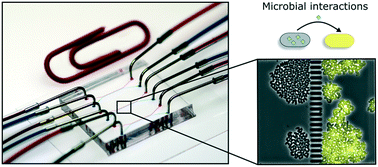A microfluidic co-cultivation platform to investigate microbial interactions at defined microenvironments†
Abstract
Interspecies interactions inside microbial communities bear a tremendous diversity of complex chemical processes that are by far not understood. Even for simplified, often synthetic systems, the interactions between two microbes are barely revealed in detail. Here, we present a microfluidic co-cultivation platform for the analysis of growth and interactions inside microbial consortia with single-cell resolution. Our device allows the spatial separation of two different microbial organisms inside adjacent microchambers facilitating sufficient exchange of metabolites via connecting nanochannels. Inside the cultivation chambers cell growth can be observed with high spatio-temporal resolution by live-cell imaging. In contrast to conventional approaches, in which single-cell activity is typically fully masked by the average bulk behavior, the small dimensions of the microfluidic cultivation chambers enable accurate environmental control and observation of cellular interactions with full spatio-temporal resolution. Our method enables one to study phenomena in microbial interactions, such as gene transfer or metabolic cross-feeding. We chose two different microbial model systems to demonstrate the wide applicability of the technology. First, we investigated commensalistic interactions between an industrially relevant L-lysine-producing Corynebacterium glutamicum strain and an L-lysine auxotrophic variant of the same species. Spatially separated co-cultivation of both strains resulted in growth of the auxotrophic strain due to secreted L-lysine supplied by the producer strain. As a second example we investigated bacterial conjugation between Escherichia coli S17-1 and Pseudomonas putida KT2440 cells. We could show that direct cell contact is essential for the successful gene transfer via conjugation and was hindered when cells were spatially separated. The presented device lays the foundation for further studies on contactless and contact-based interactions of natural and synthetic microbial communities.

- This article is part of the themed collection: Lab on a Chip Recent HOT Articles


 Please wait while we load your content...
Please wait while we load your content...